Episode 405: Anteaters and the Capelobo
Description
Thanks to Molly and Mila for suggesting the anteater and its relations this week!
Further reading:
How anteaters lost their teeth
The giant anteater has a long tongue and a little mouth, and adorable babies:
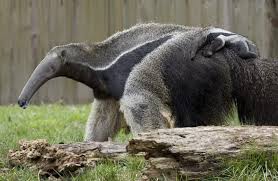
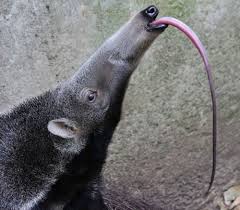
The giant anteater has a weird skull [photos by Museum of Veterinary Anatomy FMVZ USP CC BY-SA 4.0, https://commons.wikimedia.org/w/index.php?curid=72183871]:
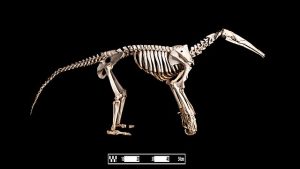
The tamandua is like a mini giant anteater that can climb trees:
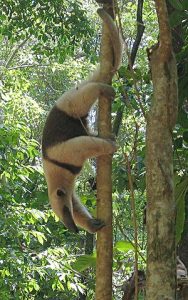
The silky anteater looks like a weird teddy bear [photo by Quinten Questel – Own work, CC BY-SA 3.0, https://commons.wikimedia.org/w/index.php?curid=30287945]:
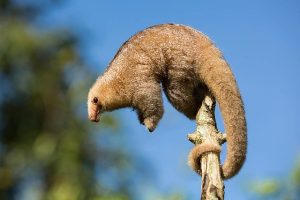
Show transcript:
Welcome to Strange Animals Podcast. I’m your host, Kate Shaw.
This week we’re going to talk about some unusual mammals, suggested by Molly and Mila. It’s a topic I’ve been meaning to cover for almost two years and now we’re finally going to learn about it! It’s the anteater and its close relations, including a creepy anteater cryptid that would have fit in just fine during monster month.
A lot of animals are called anteaters because they eat ants, but the anteaters we’re talking about today belong to the suborder Vermilingua, meaning “worm tongue.” That’s because they all have long, sticky tongues that they use to lick up ants, termites, and other insects. Anteaters are native to Central and South America and are closely related to sloths, and more distantly related to armadillos.
The sloth and anteater share a common ancestor who lived around 60 million years ago, a little animal that mainly ate worms and insect larvae and probably lived in burrows. Because its food was soft and didn’t need a lot of chewing, when a mutation cropped up that caused its teeth to be weak, it didn’t matter. It wasn’t using its teeth anyway. When the first anteaters evolved from this ancestral species, they didn’t need teeth either, and gradually they lost their teeth entirely. Modern anteaters have no teeth at all.
Sloths also evolved from this weak-toothed ancestor, and sloths eat plants. Plants need a lot of chewing, and most animals that eat plants have really strong teeth, but sloths retained the genetics for weak teeth. They don’t even have an enamel coating on their teeth, and instead of grinding molars, their teeth are basically soft little pegs. Luckily for the sloth, the little peg teeth do continue to grow throughout its life, so it never wears its teeth down so far it can’t chew.
Anteaters, sloths, and their distant relation the armadillo all share the same type of vision from their shared ancestor too. They can’t see colors at all but have good vision in low light, which is why scientists think they all evolved from an animal that spent most of its time underground hunting for worms. Anteaters have strong claws that allow them to dig into termite and ant nests, and armadillos spend a lot of time in burrows they dig. We don’t actually know what the common ancestor of these related animals looked like because we haven’t found any fossils of it yet.
In the past, scientists thought that pangolins and aardvarks were related to anteaters because they all have similar adaptations to a similar diet, but that’s just another example of convergent evolution. We talked about pangolins and aardvarks back in episode 65, as well as the giant anteater.
The giant anteater is the one most people know about. It earns the name giant because it can grow almost eight feet long, or 2 1/2 meters, if you include the tail. Its fur is brown and cream with a distinctive black stripe from its chest to its back that scientists used to think acted as camouflage. Because the black fur is outlined with white, making it stand out, scientists now think it’s used as a warning to potential predators, because the giant anteater can be dangerous. If it feels threatened, it will rear up on its hind legs, using its long tail as a prop, to slash at a predator. Its claws are so big that it knuckle-walks on its forepaws.
The female anteater has one baby at a time and while it’s small, it rides on her back. Its black stripe matches hers exactly so that potential predators don’t notice it. The giant anteater’s tail has especially long, thick fur, and it will wrap the tail over its head like a blanket in cold weather.
You know how a cartoon character can cram its head into a bottle and its head stays bottle-shaped? It kind of looks like the giant anteater did that. Its head is small and its snout is shaped like a tube, with nostrils and a tiny mouth at the end. It can’t open its jaws very far.
Anteaters eat ants, although they also love termites and will eat other small insects and insect larvae. The giant anteater uses its massive front claws to dig into anthills. Then it flicks its tongue really fast, catching insects with a combination of tiny hooklets on the tongue and sticky saliva. An anteater’s tongue is over two feet long, or 60 cm, so long that when the anteater isn’t actually eating, the tongue rolls up at the back of its skull. The base of its tongue is attached not to its throat but to its sternum, also called the breastbone.
A feeding anteater eats as many insects as it can catch in a minute or two, then moves on to find a new anthill. It does this to avoid as many stings and bites as possible. Because the anteater doesn’t have teeth, it crushes insects against the top of its mouth before swallowing them, and its stomach acts like a bird’s crop. The anteater may deliberately eat sand or grit the way birds do to help pulverize the insects it’s eaten. Its eyesight isn’t very good so it hunts mostly by scent.
To conserve energy, the anteater’s body temperature is low to start with and drops when the animal is asleep. This is another trait it shares with its relations, the sloth and the armadillo.
There are three other species of anteater alive today, the silky anteater, and the northern and southern tamanduas. The tamandua, both northern and southern, looks like a miniature giant anteater but is typically less than half its size. The southern tamandua lives throughout much of South America while the northern tamandua lives throughout Central America, and both species look very similar. They don’t have the black warning stripe that the giant anteater has, though, and because they’re smaller and lighter, they can climb trees to find insects, which allows them to live in the same areas as giant anteaters without competing with them for food. They eat ants, termites, and the larvae of lots of other insects, and will also eat fruit. The tamandua has a partially prehensile tail that helps it climb trees.
The silky anteater is also called the pygmy anteater, because it’s the smallest species, only growing about 18 inches long, or 45 cm. That includes its partially prehensile tail. It lives in Central America and much of northern South America, and unlike the giant anteater that prefers savannas and open forests, the silky anteater lives in lowland rainforests because it spends its life in trees.
The silky anteater also doesn’t look much like the giant anteater. It kind of looks like a weird teddy bear with a long tail, and kind of looks like a weird sloth with a long tail. Its fur is short but fluffy, light brown or cream-colored, and some scientists think this makes it look like the seed pod of the silk cotton tree that’s common throughout its range and which it prefers. It sleeps curled up in a ball that also helps it look more like a seed pod.
The silky anteater has two long, sharp claws on its front feet, which it uses to climb trees, break open wasp nests, and defend i





